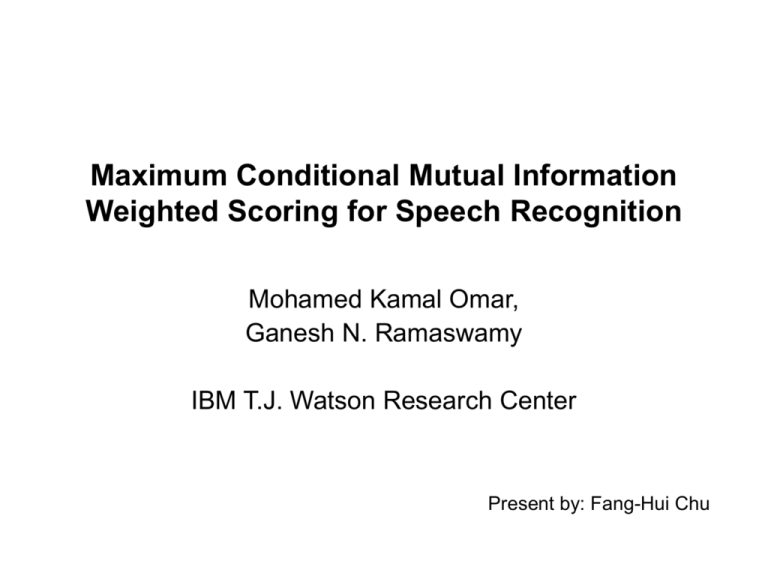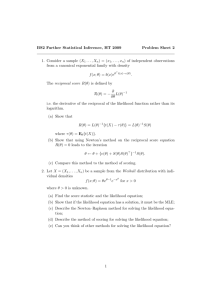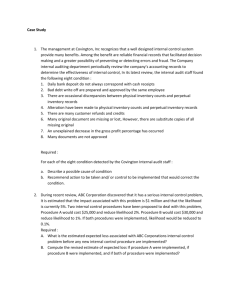Maximum Conditional Mutual Information Weighted Scoring for
advertisement

Maximum Conditional Mutual Information Weighted Scoring for Speech Recognition Mohamed Kamal Omar, Ganesh N. Ramaswamy IBM T.J. Watson Research Center Present by: Fang-Hui Chu outline • • • • • Introduction Problem formulation Implementation Experiments and results Discussion 2 introduction • This paper describes a novel approach for extending the prototype Gaussian mixture model – achieved by estimating weighting vectors to the log likelihood values due to different elements in the feature vector • The weighting vectors which maximize an estimate of the conditional mutual information between the log likelihood score and a binary random variable representing whether the log likelihood is estimated using the model of the correct label or not 3 introduction • This estimate of the mutual information is conditioned on the maximum likelihood estimated HMM model • We show that maximizing this objective function is equivalent to maximizing the differential entropy of a normalized log likelihood score – under Gaussianity assumption of the log likelihood conditional PDF given the value of the binary random variable. 4 problem formulation • The mutual information of the log likelihood score and the binary random variable is I ( S , B) H ( S ) H ( S | B) • the acoustic log likelihood values for each frame in the training data is calculated using this HMM model as skt log P (Okt | ), 5 problem formulation • Using state-dependent weighting of the contributions to the likelihood due to different feature elements and replacing the sum over the Gaussian components by the maximum n log P(Okt | ) wj log P(Oktj | m* ), j 1 where m* arg max H m P(Okt | m ) m 6 problem formulation • To be able to compare the likelihood values estimated using different HMM states and , • To guarantee that the likelihood function will integrate to one over all the observation space • It can be shown that the following constraints are necessary and sufficient wj 0 for 0 K , 0 j n, M m 1 n H m j 1 2 jm j 1 wj 1 for 0 K , w 7 problem formulation • the maximum conditional mutual information (MCMI) objective function N Tk K I kt log P skt | bkt log P skt , k 1 t 1 1 P(S ) q( B 0) P(S | B 0) q( B 1) P(S | B 1), I ( S , B) H ( S ) H ( S | B) p ( s, b) p ( s, b) log p ( s ) p (b) s ,b p ( s, b)log p ( s | b) p ( s ) s ,b 8 problem formulation • an alternative approach to calculating an estimate of the objective function – By noticing that if both P(S|B=0) and P(S|B=1) are Gaussian PDFs with mean μ0 and μ1 and variance 02and 12 respectively – Using a normalization of the log likelihood score in the form ~ skt skt b b kt , kt – the conditional differential entropy of the normalized log likelihood score, S~ , is constant – Therefore maximizing the conditional mutual information of the normalized log likelihood score, S~ , and the binary random ~ variable B is equivalent to maximizing the differential entropy of S 9 problem formulation ~ S • Since the variance of is constant, the differential entropy of the normalized log likelihood score is maximized if and only if its probability density function (PDF) is Gaussian [ref: D. P. Bertsekas, Nonlinear Programming] • Maximizing the differential entropy of the the normalized log likelihood score becomes a maximum likelihood problem 10 problem formulation • we maximize the likelihood that the normalized log likelihood score is a Gaussian random variable • In this case, the maximum differential entropy (MDE) objective function to be maximized is 1 ~ s 2 kt L kt log 2 2 2 k 1 t 1 1 N Tk K , 2 11 implementation • Our goal is to calculate the state-dependent weights of K , j n the log likelihood scores, wj 1, j 1 , which maximize the MCMI and MDE objective functions – we can use an interior point optimization algorithm with penalized objective function • Alternatively to simplify the optimization problem, we impose the constraints in Equation 5 by normalizing the weights of the Gaussian components of each state model using the relation H mr n j 1 H m 2 jm 1 wjr wjr 12 implementation • This is an optimization problem over a convex set and we use the conditional gradient method to calculate the weighting vectors Wr 1 Wr r 1 (Wr Wr ), W 0 r T W arg max W W r Iˆ | W Wr , W – The Armijo rule is used to estimate the step size r 1 13 MCMI • The gradient of the MCMI objective function with respect to the state-dependent weighting vectors is Mb N Tk Iˆ s mb kt mb kt kt V kt 2 W k 1 t 1 m 1 mb Mf 1 s kt mf mf kt q( f ) kt Vkt , 2 k 1 t 1 f 0 m 1 mf N Tk – Vkt skt 0 , skt1 ,..., sktj ,..., sktn is the vector of log likelihood values for frame t of utterance k using the state ρ corresponding to different elements in the feature vector 14 MDE • The gradient of the MDE objective function with respect to the state-dependent weighting vectors is N Tk L s kt kt Vkt W b k 1 t 1 kt 15 Experiments and results • Task: Arabic DARPA 2004 Rich Transcription (RT04) broadcast news evaluation data • 13-dimensional MFCC features computed every 10 ms. from 25-ms. frames with a Mel filter bank that spanned 0.125–8 kHz • The recognition features were computed from the raw features by splicing together nine frames of raw features (±4 frames around the current frame), projecting the 117-dim. spliced features to 60 dimensions using an LDA projection, and then applying maximum likelihood linear transformation (MLLT) to the 60-dim. projected features 16 Experiments and results • The acoustic model consisted of 5307 context-dependent states and 149K diagonal-covariance Gaussian mixtures • In the context of speaker-adaptive training to produce canonical acoustic models, we use feature-space maximum likelihood linear regression (MLLR) • The language model is a 64K vocabulary 30M n-gram interpolated back-off trigram language model • The estimation of the weights using the MCMI criterion converged after six iteration of the conditional gradient algorithm, while using the MDE criterion, it converged after four iterations 17 Experiments and results 18 Discussion • we examined an approach for state-dependent weighting of the log likelihood scores corresponding to different feature elements in the feature vector • we described two similar criteria to estimate these weights • This approach decreased the word error rate by 3% relative compared to the baseline system for both the speaker-independent and speaker-adapted systems • Further investigation of the performance of our approach on other evaluation tasks will be our main goal 19








